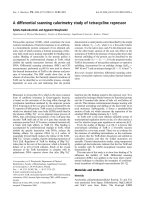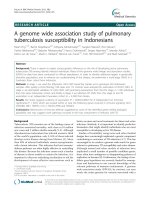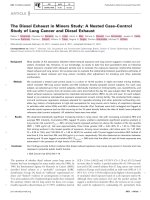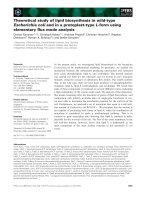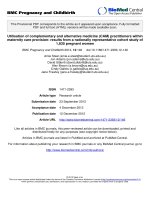A validated molecular docking study of lipid–protein interactions
Bạn đang xem bản rút gọn của tài liệu. Xem và tải ngay bản đầy đủ của tài liệu tại đây (10.49 MB, 449 trang )
A Validated Molecular Docking Study of
Lipid–Protein Interactions
Rajyalakshmi Gaddipati
College of Engineering and Science
Victoria University
Submitted in fulfillment of the requirements of the degree of
Doctor of Philosophy
September, 2015
1
To my mother, father, husband, mother-in-law and children, with all
my love and respect
2
Abstract
The interaction of proteins with lipids is an important aspect of research as it plays a main
role in various biological responses such as metabolic pathways, signal transduction and in
drug discovery. Proteins that take part in the treatment of different diseases act as drug targets
and hence research is ongoing to find new series of ligands of medicinally significant
proteins. Few such proteins, peroxisome proliferator activated receptors (PPARs), retinoid
receptors, cannabinoid receptors (CB1 and CB2), lipoxygenase (LOX), cyclooxygenases
(COXs) were selected for the author’s study due to their therapeutic role to act as
pharmacological targets. The existing ligands for these protein targets are causing some side
effects. For example, thiazolidinediones are the currently used ligands for PPARs.
Thiazolidinediones bind to PPARs and used in the treatment of diabetes. However, this
treatment results in obesity. Similarly, the use of Nonsteroidal Anti-inflammatory Drugs
(NSAIDs) like aspirin and ibuprofen lead to stomach or gastrointestinal ulcers, heartburn,
headache and dizziness. Hence, a set of ligands which have a significant role in the treatment
of diseases were selected and compared for their binding affinities towards the design of a
new series of drugs.
In order to find the new series of ligands of the above proteins, three groups of lipid
ligands— tocotrienols (α, β, γ and δ tocotrienols), omega 3 fatty acids (Docosahexaenoic acid
(DHA), Eicosapentaenoic acid (EPA)) and endocannabinoids (anandamide and 2-arachidonyl
glycerol) —were tested for their ability to bind to PPARs, CBs and COX-2. Two molecular
docking programs, AutoDock and Glide, were used to study the above lipid-protein
interactions. The stability of docked complexes was tested through molecular dynamic
simulations. Further, the in silico results were validated with in vitro experimental results.
3
The three groups of lipid ligands were provided same conditions in both in vitro and in silico
experiments. Still, omega 3 fatty acids have shown strong interactions with PPARs and
retinoid receptors. This is because of the ligand binding cavity of PPARs and retinoid
receptors that accommodates polyunsaturated fatty acids better than the other ligands. Among
the fatty acids, omega 3 fatty acids possess most potent immunomodulatory activities and
among omega 3 fatty acids DHA and EPA are biologically more potent. Furthermore, DHA
and EPA have anti-inflammatory and cancer preventing properties.
COX-2 also has shown strong binding interactions with DHA in both virtual and wet
laboratory experiments compared to the other ligands. Next to omega 3 fatty acids,
endocannabinoids have exhibited strong affinity with COX-2. Tocotrienols did not show
favorable binding interactions with cyclooxygenases due to their orientation and structure
which failed to fit into the binding pocket of cyclooxygenases. The ligand binding cavity of
COX-2 is larger than COX-1 and hence COX-2 has shown strong binding interactions with
the ligands compared to COX-1. Endocannabinoids have shown strong binding interactions
with both cannabinoid receptors compared to the other two groups of lipid ligands.
A web-based validated tool, Lipro Interact was developed with the results of all the above
lipid-protein interactions. The purpose of Lipro Interact was to provide the author’s study of
80 lipid-protein interactions for global use. Lipro Interact provided the detailed information
on the binding affinities of each lipid-protein interaction along with the microscopic atomic
interactions, bond distances and ligand binding sites. The advantage of Lipro Interact is that
all the lipid-protein interacting studies included were downloadable in image form. Further,
Lipro Interact allows the users to download the PDB files of the above lipid-protein
interactions. Future versions of Lipro Interact can calculate the binding affinity for any pair
of protein and ligand.
4
Student Declaration
“I, Rajyalakshmi Gaddipati, declare that the PhD thesis entitled “The Study of
Lipid-Protein Interactions towards the Design of Lipro Interact- A Validated Web
based Tool” is no more than 100,000 words in length including quotes and exclusive of
tables, figures, appendices, bibliography, references and footnotes. This thesis contains no
material that has been submitted previously, in whole or in part, for the award of any other
academic degree or diploma. Except where otherwise indicated, this thesis is my own work”.
Signature: Rajyalakshmi. G
Date: 03/09/2015
5
Acknowledgements
First, I would like to thank my Master and God for everything. I would like to thank my
husband who was with me all the times providing his support. My full respect and thanks to
my mother and mother-in-law who helped me in looking after my kids during my PhD
studies. I would like to thank my daughters who did not ever disturb me while I am studying.
I would like to extend my deep thanks and gratitude to all the people who contributed to
enrich my knowledge and improve my competencies.
I am grateful to my principal supervisor Dr. Gitesh Raikundalia who guided me throughout
my project and provided me with his valuable comments and advises. Further, I would like to
thank my co-supervisor Dr. Michael Mathai without whose encouragement and support, this
research would not have been completed. I would like to thank Dr. John Orbell for his
valuable guidance provided at the beginning stages of my project. I would like to extend my
deep thanks to Dr. Mike Kuiper for providing his suggestions required for the entire project. I
would like to thank Dr. Elizabeth Yuriev for her help in guiding me in molecular docking
techniques.
I would like to extend my thanks to Dr. Phil Beart for giving me permission to work with
Howard Florey Laboratories. I would like to thank Dr. Linda Lau for supervising my project
for the period of my wet laboratory experiments at Howard Florey Institute. I would like to
thank Victoria University for giving me the scholarship for my project. I would like to thank
Howard Florey Institute for allowing me to conduct my wet laboratory experiment in Beart
lab. Finally, I would like to thank all my peers, for all the fun we have had together in the last
four years.
6
List of Publications
Gaddipati, R.S., Raikundalia, G.K., & Mathai, M.L. (2012). Towards the Design of PPAR
Based drugs Using Tocotrienols as Natural Ligands. Paper presented at the International
Conference on Engineering and Science, Beijing.
Gaddipati, R.S., Raikundalia, G.K., & Mathai, M.L. (2014). Dual and selective lipid
inhibitors of cyclooxygenases and lipoxygenase: a molecular docking study. Medicinal
Chemistry Research, 23 (7), 3389-3402.
Gaddipati, R.S, Raikundalia, G.K., & Mathai, M.L. (2014). Comparison of AutoDock and
Glide towards the Discovery of PPAR Agonists. International Journal of Bioscience,
Biochemistry and Bioinformatics, 4 (2), 100-105.
7
Table of Contents
Chapter 1 : Thesis overview ............................................................................................................... 21
1.1.
Introduction ............................................................................................................... 21
1.2.
Research Question..................................................................................................... 25
1.2.1.
Gaps and Limitations of Previous Research ................................................................. 27
1.3. Aims of this Research ..................................................................................................... 30
1.4.
Originality and Uniqueness of the Research............................................................. 32
1.5.
Significance of the Research ..................................................................................... 34
1.6.
Organization of the Thesis ........................................................................................ 36
Chapter 2 : Literature Review ........................................................................................................... 39
2.2. Ligand-Receptor Interactions ......................................................................................... 41
2.3. Lipid Ligands .................................................................................................................. 42
2.3.1. Tocotrienols ........................................................................................................................ 43
2.3.2.
Omega 3 Fatty Acids ..................................................................................................... 48
2.3.3.
Endocannabinoids......................................................................................................... 52
2.4.
Target Proteins.......................................................................................................... 56
2.4.1. Therapeutic Proteins and Their Significance ..................................................................... 58
2.4.2. Mutations in Target Proteins .............................................................................................. 61
2.4.2.1. Mutations in PPAR-α ....................................................................................................... 63
2.4.2.2. Mutations in PPAR-γ isoform1 ........................................................................................ 63
2.4.2.3. Mutations in PPAR-γ isoform2 ........................................................................................ 64
8
2.4.2.4. Mutations in SXR ............................................................................................................. 64
2.4.2.5. Mutations in RXR-α.......................................................................................................... 64
2.4.2.6. Mutations in RXR-γ .......................................................................................................... 65
2.4.2.7. Mutations in RAR-α.......................................................................................................... 65
2.4.2.8. Mutations in FXR ............................................................................................................. 65
2.4.3. Pathways of Target Proteins ............................................................................................... 66
2.4.4. Active Sites of Target Proteins ............................................................................................ 68
2.5.
Bioinformatics Tools to Assess the Lipid-Protein Interactions................................. 71
2.5.1.
Lipid Structural Databases and Tools .......................................................................... 72
2.5.2.
Protein Structural Databases........................................................................................ 74
2.5.3.
Bioinformatics Tools to Study the Active Site of Proteins ............................................. 76
2.5.4.
Molecular Docking Tools for the Study of Lipid-Protein Interactions ......................... 78
2.5.5.
Molecular Dynamic Simulations ................................................................................... 82
2.5.6.
Experimental Validation ............................................................................................... 83
2.6.
Novelty and Uniqueness of Contribution .................................................................. 84
2.7.
Conclusion................................................................................................................. 86
Chapter 3: Bioinformatic and Biochemical Methods to Create Lipro Interact Software ............. 88
3.1. Introduction .................................................................................................................... 88
3.2. Methodology Framework ............................................................................................... 89
3.2.1.
Biochemical Component ............................................................................................... 91
3.2.2. Lipro Interact ...................................................................................................................... 91
3.3. Selection of Molecular Docking Tool ............................................................................. 92
3.4. Molecular Docking Studies using AutoDock .................................................................. 93
9
3.4.1.
Ligand Preparation ....................................................................................................... 94
3.4.2.
Protein Preparation ...................................................................................................... 95
3.4.3.
Receptor Grid Generation ............................................................................................ 99
3.4.4.
Docking with AutoDock .............................................................................................. 100
3.5. Molecular Docking Studies using Glide ....................................................................... 104
3.5.1.
Ligand Preparation ..................................................................................................... 105
3.5.2.
Protein Preparation .................................................................................................... 106
3.5.3.
Receptor Grid Generation .......................................................................................... 107
3.5.4.
Docking Studies........................................................................................................... 108
3.5.5.
Validation of Docking Results..................................................................................... 108
3.6.
Molecular Dynamic Simulations ............................................................................. 109
3.6.1.
Theory of MD Simulations .......................................................................................... 109
3.6.2.
System Building ........................................................................................................... 111
3.6.3.
Minimization ............................................................................................................... 113
3.6.4.
Molecular Dynamics ................................................................................................... 115
3.7.
Scintillation Proximity Assay .................................................................................. 115
3.7.1.
Preparation of SPA System ......................................................................................... 116
3.7.2.
Normalization and Standardization of MicroBeta Trilux ........................................... 116
3.7.3.
Saturation Binding Assay ............................................................................................ 117
3.7.4.
Competitive Binding Assay ......................................................................................... 119
3.8.
Developing Lipro Interact ....................................................................................... 120
3.9.
Conclusion............................................................................................................... 121
10
Chapter 4 : Potential Ligands of PPARs and Retinoid Receptors ............................................... 123
4.1. Introduction .................................................................................................................. 124
4.2. DHA and EPA as Potential PPAR agonists ................................................................. 125
4.2.1. Redocking as a Docking Validation Method ..................................................................... 127
4.2.2. Molecular Docking of PPARs with Lipid Ligands using AutoDock ................................. 130
4.2.3. Molecular Docking of PPARs with Lipid Ligands using Glide ........................................ 130
4.2.4. MD Simulation of Top Ranked Poses of PPARs ............................................................... 142
4.3. Comparison of AutoDock and Glide ............................................................................ 149
4.4. RAR-γ and RXR-α ......................................................................................................... 156
4.4.1. Current Retinoid Therapies and their Limitations ............................................................ 157
4.4.2. New Series of Ligands for RAR-γ and RXR-α ................................................................... 158
4.5. Comparison of AutoDock and Glide Docking Results ................................................. 168
4.6. Conclusion .................................................................................................................... 170
Chapter 5 : Dual and Selective Lipid Ligands of Cyclooxygenase and Lipoxygenase ............... 173
5.1. Introduction .................................................................................................................. 174
5.2. Towards the Discovery of Anti-Inflammatory Drugs ................................................... 175
5.2.1. Molecular Docking Studies using AutoDock .................................................................... 176
5.2.2. Molecular Docking Studies using Glide ........................................................................... 180
5.2.3. Ligand Binding Sites of COX-1 and COX-2 ..................................................................... 186
5.2.4. Receiver Operating Characteristic Curve ........................................................................ 189
5.2.5. Molecular Dynamic Simulations ....................................................................................... 192
5.3. Comparison of AutoDock and Glide Docking Results ................................................. 197
11
5.4. Conclusion .................................................................................................................... 202
Chapter 6 : Poteintial Ligands of Cannabinoid Receptors ........................................................... 204
6.1. Introduction .................................................................................................................. 204
6.2. Cannabinoid Receptors as Therapeutic Targets .......................................................... 206
6.3. New Series of Cannabinoid Ligands ............................................................................ 207
6.3.1. Findings of AutoDock ....................................................................................................... 207
6.3.2. Findings of Glide Docking ................................................................................................ 210
6.4. Comparison of AutoDock and Glide for CB1 and CB2 ............................................... 216
6.5. Conclusion .................................................................................................................... 219
Chapter 7 : Scintillation proximity Assay....................................................................................... 221
7.1. Introduction .................................................................................................................. 221
7.1.1. Principle of the Assay ....................................................................................................... 222
7.1.2. Development of Assay ....................................................................................................... 224
7.2. Results and Calculations .............................................................................................. 225
7.2.1. Binding Theory: The Law of Mass Action......................................................................... 228
7.2.2.
Saturation Binding Analysis........................................................................................ 231
7.2.3.
Competitive Binding Analysis ..................................................................................... 238
7.3. Discussion..................................................................................................................... 246
7.4. Conclusion .................................................................................................................... 255
Chapter 8 : The Design of Lipro Interact ........................................................................................ 257
8.1.
Introduction ............................................................................................................. 257
8.2.
Development Methodology ...................................................................................... 258
12
8.2.1.
Hardware Requirements ............................................................................................. 259
8.2.2. Software System Attributes................................................................................................ 259
8.2.3. Performance Requirements ............................................................................................... 259
8.3.
Review of Implementation Issues ............................................................................ 260
8.3.1. Implementation Environment ............................................................................................ 260
8.3.2. Development Platform ...................................................................................................... 260
8.3.3. Windows Platform Framework (.NET) and Programming Language (C#)...................... 261
8.3.4. Front End UI Framework (.NET Tool kit) ........................................................................ 262
8.3.5. Programming Environment............................................................................................... 263
8.4.
Design of Lipro Interact .......................................................................................... 264
8.4.1.
Software Architecture ................................................................................................. 266
8.4.2. Design of Lipro Interact .................................................................................................... 266
8.4.3. Results Analysis in Bioinformatic Component .................................................................. 276
8.4.4. Results Analysis in Biochemical Component .................................................................... 285
8.4.5. Code Used to Develop Lipro Interact ............................................................................... 286
8.4.6. Data Exceptions ................................................................................................................ 289
8.5. Structure of Lipro Interact............................................................................................ 289
8.6. Conclusion .................................................................................................................... 290
Chapter 9 : Conclusions and Future Work .................................................................................... 292
9.1. Introduction .................................................................................................................. 292
9.2. Key Contributions of the Research ............................................................................... 294
9.3. Future Work .................................................................................................................. 298
Abbreviations ....................................................................................................................... 302
13
References ............................................................................................................................ 304
Appendices ........................................................................................................................... 328
Appendix-A .......................................................................................................................... 328
Appendix-B .......................................................................................................................... 329
Appendix-C .......................................................................................................................... 330
Appendix-D .......................................................................................................................... 332
Appendix-E .......................................................................................................................... 334
Appendix-F .......................................................................................................................... 336
Appendix-G .......................................................................................................................... 337
Appendix-H .......................................................................................................................... 339
Appendix-I ........................................................................................................................... 341
Appendix-J ........................................................................................................................... 342
Appendix-K .......................................................................................................................... 362
Appendix-L .......................................................................................................................... 397
Appendix-M ......................................................................................................................... 423
Table of Figures
Figure 2.1 Structure of α-tocotrienol .................................................................................................... 43
Figure 2.2 Structure of β-tocotrienol..................................................................................................... 44
Figure 2.3 Structure of δ-tocotrienol..................................................................................................... 44
Figure 2.4 Structure of γ-tocotrienol ..................................................................................................... 45
Figure 2.5 Known Targets of tocotrienols with different targets and enzymes .................................... 48
Figure 2.6 Structure of DHA................................................................................................................. 49
Figure 2.7 Structure of EPA.................................................................................................................. 49
14
Figure 2.8 Known targets of omega 3 fatty acids with different targets and enzymes ......................... 52
Figure 2.9 Structure of anandamide ...................................................................................................... 53
Figure 2.10 Structure of 2AG ............................................................................................................... 53
Figure 2.11 Known targets of endocannabinoids with different targets and enzymes ......................... 56
Figure 2.12 Screen shot of downloading three dimensional lipid structures ........................................ 74
Figure 3.1 Methodology Framework .................................................................................................... 90
Figure 3.2 System Building of LOX-BTT .......................................................................................... 112
Figure 3.3 Minimization of LOX-BTT ............................................................................................... 114
Figure 4.1 Redocking of PPAR-α with Crystal Ligand CTM............................................................. 127
Figure 4.2 Redocking of PPAR-δ with Crystal Ligand D-32 ............................................................ 128
Figure 4.3 Redocking of PPAR-γ with Crystal Ligand CTM ............................................................. 129
Figure 4.4 Interaction of PPAR-α with DHA ..................................................................................... 130
Figure 4.5 Interaction of PPAR-α with α-tocotrienol ......................................................................... 132
Figure 4.6 Interaction of PPAR-δ with EPA ....................................................................................... 134
Figure 4.7 Interaction of PPAR-δ with δ-tocotrienol .......................................................................... 135
Figure 4.8 Interaction of PPAR-γ with EPA ....................................................................................... 136
Figure 4.9 Interaction of DHA with PPAR-α ..................................................................................... 138
Figure 4.10 Ligplot diagram of PPAR-α with DHA ........................................................................... 139
Figure 4.11 Interaction of PPAR-δ with DHA.................................................................................... 140
Figure 4.12 LigPlot diagram of PPAR-γ with DHA ........................................................................... 141
Figure 4.13 Interaction of PPAR-γ with DHA .................................................................................... 142
Figure 4.14 RMSD curve of PPAR-α with DHA in 2ns time period.................................................. 143
Figure 4.15 RMSD curve of PPAR-α with DHA in 4ns time period.................................................. 144
Figure 4.16 RMSF curve of PPAR-α with DHA ............................................................................... 144
Figure 4.17 RMSD curve of PPAR-β with DHA................................................................................ 146
Figure 4.18 RMSF curve of PPAR-β with DHA ................................................................................ 147
Figure 4.19 RMSD curve of PPAR-γ with DHA ................................................................................ 148
Figure 4.20 RMSF curve of PPAR-γ with DHA................................................................................ 149
15
Figure 4.21 Comparison of Binding Energies of PPAR-α in AutoDock and Glide ........................... 154
Figure 4.22 Comparison of Binding Energies of PPAR δ in AutoDock and Glide ............................ 155
Figure 4.23 Comparison of Binding Energies of PPAR-γ in AutoDock and Glide ............................ 155
Figure 4.24 Binding of RAR-γ with DHA .......................................................................................... 160
Figure 4.25 Binding of RXR-α with DHA.......................................................................................... 161
Figure 4.26 Binding of RAR-γ with DHA .......................................................................................... 162
Figure 4.27 LigPlot diagram of RAR-γ with DHA ............................................................................. 163
Figure 4.28 Binding of RXR α with DHA .......................................................................................... 164
Figure 4.29 LigPlot of RXR α with DHA ........................................................................................... 164
Figure 4.30 RMSD curve of the docked complex RAR-γ-DHA ........................................................ 166
Figure 4.31 RMSF plot of the docked complex RAR-γ-DHA............................................................ 167
Figure 4.32 RMSD curve of the docked complex RXR-α -DHA ....................................................... 167
Figure 4.33 RMSF plot of the docked complex RXR-α-DHA ........................................................... 168
Figure 4.34 Comparing AutoDock and Glide for RAR-γ and RXR-α ................................................ 169
Figure 4.35 RAR-γ: AutoDock Vs Glide ............................................................................................ 169
Figure 4.36 RXR-α: AutoDock Vs Glide ........................................................................................... 170
Figure 5.1 Interaction of COX-1 with EPA ....................................................................................... 177
Figure 5.2 Interaction of COX-2 with DHA ....................................................................................... 178
Figure 5.3 Interaction of LOX with β-tocotrienol............................................................................... 179
Figure 5.4 Ligand Interaction: COX-1-EPA ....................................................................................... 181
Figure 5.5 Ligand Interaction: COX-2-DHA ...................................................................................... 185
Figure 5.6 Ligand Interaction: LOX-β tocotrienol.............................................................................. 185
Figure 5.7 Ligand Binding Site of COX-1 .......................................................................................... 187
Figure 5.8 Ligand Binding Site of COX-2 .......................................................................................... 188
Figure 5.9 LigPlot imgage of COX-1 binding to DHA ...................................................................... 188
Figure 5.10 LigPlot imgage of COX-1 binding to DHA .................................................................... 189
Figure 5.11 ROC curve for the enzyme COX-1 ................................................................................. 191
Figure 5.12 ROC curve for the enzyme COX-2 ................................................................................. 191
16
Figure 5.13 ROC curve for the enzyme LOX ..................................................................................... 192
Figure 5.14 RMSD Plot of COX-1-EPA Docked Complex ............................................................... 193
Figure 5.15 RMSF Plot of COX-1-EPA Docked Complex ................................................................ 194
Figure 5.16 RMSD Plot of COX-2-DHA Docked Complex .............................................................. 194
Figure 5.17 RMSF Plot of COX-2-DHA Docked Complex ............................................................... 195
Figure 5.18 RMSD Plot of LOX-βTT Docked Complex.................................................................... 195
Figure 5.19 RMSF Plot of LOX-βTT Docked Complex .................................................................... 196
Figure 5.20 COX-1, COX-2 & LOX: AutoDock Vs Glide ................................................................ 197
Figure 5.21 COX-1: AutoDock Vs Glide ........................................................................................... 200
Figure 5.22 COX-2: AutoDock Vs Glide ........................................................................................... 201
Figure 5.23 LOX: AutoDock Vs Glide ............................................................................................... 201
Figure 6.1 Binding of Anandamide to CB1 ........................................................................................ 208
Figure 6.2 Binding of anandamide to CB2 ......................................................................................... 210
Figure 6.3 Binding of 2AG to CB1 ..................................................................................................... 211
Figure 6.4 Interactions of 2AG with CB1 ........................................................................................... 212
Figure 6.5 Binding of Anandamide with CB2 .................................................................................... 213
Figure 6.6 Interactions of 2AG with CB2 ........................................................................................... 214
Figure 6.7 Comparison of AutoDock and Glide for CB1 and CB2 .................................................... 216
Figure 6.8 Comparison of AutoDock and Glide for all the ligands with CB1 .................................... 216
Figure 6.9 Comparison of AutoDock and Glide for all the ligands with CB2 .................................... 217
Figure 7.1 SPA using flash plates ....................................................................................................... 223
Figure 7.2 Error values in the calculation of Kd and Ki ...................................................................... 230
Figure 7.3 Total binding of PPAR-γ with C14DHA ........................................................................... 232
Figure 7.4 Specific binding of PPAR-γ with C14DHA........................................................................ 234
Figure 7.5 Saturation binding of COX-2 with C14DHA at different times ......................................... 236
Figure 7.6 Total binding of COX-2 with C14DHA.............................................................................. 236
Figure 7.7 Specific binding of COX-2 with C14DHA ......................................................................... 238
Figure 7.8 Binding of C14EPA to PPAR-γ in presence of unlabeled DHA......................................... 241
17
Figure 7.9 Competitive binding of PPAR-γ ........................................................................................ 242
Figure 7.10 Competitive binding of COX-2 with labelled DHA and unlabeled arachidonic acid ..... 243
Figure 7.11 Competitive binding of COX-2 with labelled DHA and unlabeled arachidonic acid ..... 245
Figure 7.12 COX-2-Competitive Binding .......................................................................................... 246
Figure 7.13 Ki values from AutoDock ................................................................................................ 247
Figure 8.1 Downloading the information from Lipro Interact ........................................................... 264
Figure 8.2 Functionality of Lipro Interact .......................................................................................... 265
Figure 8.3 Architecture of Lipro Interact ........................................................................................... 266
Figure 8.4 Welcome Page of Lipro Interact ....................................................................................... 267
Figure 8.5 Instructions on welcome page ........................................................................................... 268
Figure 8.6 Instructions on welcome page ........................................................................................... 268
Figure 8.7 List of proteins in the bioinformatic component of Lipro Interact.................................... 269
Figure 8.8 List of ligands in the bioinformatic component of Lipro Interact ..................................... 270
Figure 8.9 List of protein-ligand interactions in the bioinformatic component of Lipro Interact ...... 270
Figure 8.10 The Bioinformatic component of Lipro Interact ............................................................. 271
Figure 8.11 List of protein in the biochemical component of Lipro Interact ..................................... 272
Figure 8.12 List of validated options in the biochemical component of Lipro Interact ..................... 272
Figure 8.13 Experimental validation of Lipro Interact ....................................................................... 273
Figure 8.14 Binding information about PPARs .................................................................................. 274
Figure 8.15 Comparing the AutoDock and Glide for Cannabinoid Receptors ................................... 275
Figure 8.16 Downloading PDB files ................................................................................................... 275
Figure 8.17 Using AutoDock binding energy in Lipro Interact ......................................................... 276
Figure 8.18 Using Glide Score as binding energy in Lipro Interact ................................................... 277
Figure 8.19 Preparing the protein structure using VMD..................................................................... 277
Figure 8.20 Different drawing methods of VMD ............................................................................... 278
Figure 8.21 Preparing ligand structure using VMD ............................................................................ 279
Figure 8.22 Interacting amino acids of protein with ligand ................................................................ 280
Figure 8.23 Labelling the atoms of protein and ligand ....................................................................... 281
18
Figure 8.24 Adjusting the image lay out ............................................................................................. 281
Figure 8.25 Importing the protein-ligand docked structure into Maestro suite .................................. 282
Figure 8.26 Generating the ligand interaction diagram ...................................................................... 282
Figure 8.27 Preparing the image using LigPlot .................................................................................. 283
Figure 8.28 Preparing the bar chart using Excel sheet ........................................................................ 284
Figure 8.29 Comparison of AutoDock results with SPA .................................................................... 285
Figure 8.30 Comparison of Glide results with SPA............................................................................ 286
Figure 8.31 XML Source code............................................................................................................ 287
Figure 8.32 Code used to develop Lipro Interact ............................................................................... 288
Table of Tables
Table 2.1 Therapeutic role of targets .................................................................................................... 57
Table 2.2 Computational tools and databases of lipids ......................................................................... 73
Table 2.3 Computational tools and databases of proteins ..................................................................... 75
Table 2.4 Computational tools and databases for the study of ligand binding site of proteins ............. 77
Table 2.5 Computational tools and databases for the study of lipid-protein interaction....................... 80
Table 3.1 Target proteins and lipid ligands........................................................................................... 91
Table 3.2 Protein Input Structure Information .................................................................................... 106
Table 4.1 Lowest Binding Energies of PPAR-α calculated by AutoDock ......................................... 131
Table 4.2 Binding affinities of PPAR-β with lipid ligands calculated by AutoDock ......................... 132
Table 4.3 Binding affinities of PPAR-γ with Lipid Ligands calculated by AutoDock ....................... 135
Table 4.4 Glide Score of PPAR-α with Lipid Ligands ....................................................................... 138
Table 4.5 Glide Score of PPAR-δ with Lipid Ligands ....................................................................... 140
Table 4.6 Glide Score of PPAR- with lipid ligands ............................................................................ 141
Table 4.7 Interacting amino acids of PPARs with lipid ligands in AutoDock and Glide ................... 151
Table 4.8 Binding Affinities of RAR-γ and RXR-α in AutoDock...................................................... 159
Table 4.9 Glide Score of RAR-γ and RXR-α ..................................................................................... 162
Table 5.1 Binding affinities of COX-1 with lipid ligands in AutoDock ............................................. 177
19
Table 5.2 Binding affinities of COX-2 with lipid ligands in AutoDock ............................................. 179
Table 5.3 Binding affinities of LOX with lipid ligands in AutoDock ................................................ 180
Table 5.4 Glide score of COX-1 with eight lipid ligands ................................................................... 180
Table 5.5 Glide Score of COX-2 with eight lipid ligands................................................................... 183
Table 5.6 Glide Score of LOX with eight lipid ligands ...................................................................... 186
Table 5.7 Common Interacting amino acids in AutoDock and Glide ................................................. 198
Table 6.1 Binding Affinities of CB1 with eight lipid ligands in AutoDock ....................................... 208
Table 6.2 Binding Affinities of CB2 with eight lipid ligands in AutoDock ....................................... 209
Table 6.3 Glide Score of CB1 with lipid ligands ................................................................................ 212
Table 6.4 Glide Score of CB2 with lipid ligands ................................................................................ 215
Table 6.5 Interacting amino acids of CB1 and CB2 in both AutoDock and Glide ............................. 218
Table 7.1 Total binding of PPAR-γ with C14DHA.............................................................................. 232
Table 7.2 Specific binding of PPAR-γ with C14DHA ......................................................................... 233
Table 7.3 Total binding of COX-2 with C14DHA ............................................................................... 237
Table 7.4 Specific binding of COX-2 with C14DHA .......................................................................... 237
Table 7.5 Binding of C14EPA to PPAR-γ in presence of unlabeled DHA .......................................... 240
Table 7.6 Competitive binding of COX-2 with labelled DHA and unlabeled arachidonic acid ......... 243
Table 7.7 Difference between AutoDock Ki and experimental Ki ...................................................... 248
Table 7.8 Validation of Glide docking with SPA results .................................................................... 250
Table 8.1 Hardware Specification....................................................................................................... 259
20
Chapter 1: Thesis Overview
Chapter 1
Thesis Overview
1.1. Introduction
Two or more atoms join together to form molecules. If these molecules are present in a living
organism, they are termed as biomolecules. Biomolecules can be either large (macro
molecules) or small. Usually, macromolecules have a complex three-dimensional structure.
Proteins, lipids, carbohydrates and nucleic acids are some of the biomolecules present in a
living organism. The structure, properties and function of these biomolecules is important in
maintaining proper health. However, the structure, properties and function of biomolecules
change when they interact with each other. Physical or chemical interaction between two
biomolecules is called a biomolecular interaction.
When two of the above mentioned biomolecules bind together or interact with each other,
they trigger biological responses which play an important role in clinical research. Hence it is
necessary to understand the mechanism involved in the binding of two biomolecules.
Moreover, due to the complex three dimensional structures of biomolecules, studying their
interaction needs more focus. Depending on the strength and significance of binding between
two biomolecules, their interaction is used in different research areas like drug discovery,
clinical research, health informatics etc. (Huber & Muller, 2006). The significance of any
21
Chapter 1: Thesis Overview
biomolecular interaction is determined by the role played by these biomolecules in health and
disease.
Proteins are macromolecules and are one of the building blocks of life.
The three-
dimensional structure of protein is complex with many amino acids. Proteins are used as drug
targets due to their significant role in the metabolic or signalling pathway specific to a disease
condition. Basically, a drug is an organic molecule that activates or inhibits the function of a
protein. In order to design drugs, proteins are either activated or inhibited with small
molecules known as ligands. Therefore, to design a new series of drugs, the study of proteinligand interactions plays a crucial role. Drugs are designed based on the ligand binding site
which either activate or inhibit the protein function (Anderson, 2003). Designing drugs using
a ligand-based approach is called ligand-based drug design (Aparoy et al., 2012). If the
ligand is a lipid binding to protein, this is a lipid-protein interaction which is ultimately used
for the design of a new generation of drugs.
In order to consider a particular lipid-protein interaction for the drug designing the
mechanism of this lipid-protein interaction has to be analyzed further. To achieve this, the
effect of lipid-protein interaction should be studied in vivo. To consider a particular ligand as
an effective drug candidate, the action of ligand has to be studied in vivo. Further the
mechanism of action of ligand and the effect of ligand on a particular biological reaction has
to be analyzed. The metabolism of ligand-protein interaction has to be studied.
Lipids are a group of organic compounds that are insoluble in water and soluble in organic
solvents. Lipids, commonly known as fats are a group of naturally occuring biomolecules.
Fatty acids, waxes, fat soluble vitamins A, D, E and K belong to lipids. Lipids are one of the
energy reserves of the body and supply it when the body is in need. They also play an
important role in signalling by interacting with various enzymes and receptors. Tocotrienols,
22
Chapter 1: Thesis Overview
omega 3 fatty acids and endocannabinoids are three important groups of lipids in health and
disease. These three classes of lipids have a relationship between them in terms of their
binding affinities to the same enzyme or receptor, yet they induce very different biological
outcomes. This commonality of binding makes it important to be able to determine the
affinity of lipids within each of these lipid classes to different signalling targets. The research
on the interactions of these classes of lipids with different receptors is interesting as the three
lipid groups play a vital role in cancer research, bone health, atherosclerosis and other
cardiovascular diseases.
Ligand-receptor interactions play an important role in many biological processes as well as in
the treatment of many diseases (Bongrand, 1999). The strength of ligand-receptor binding
depends on several factors including the structures of the ligand and receptors. The type of
ligand-receptor interaction is based on the type of biomolecules involved. For example, if the
ligand is protein and the receptor is also a protein then it is protein-protein interactions.
Similarly, if the ligand is a lipid and the receptor is protein then it is termed as lipid-protein
interaction. However, in the case of enzymes the ligand is usually considered as a substrate
and this type of interaction is known as enzyme-substrate interaction. Whatever is the type of
interaction, a detailed mechanism involved in binding of both the molecules has to be more
focussed.
Ligand-receptor interactions have become the fundamental basis for the design of drugs.
Drug designing is also known as ligand designing, because it involves the design of a small
molecule that binds tightly to its target (Tollenaere, 1996). The strength of binding between
ligand and receptor is measured in terms of binding affinity between them. In other words
binding affinity or binding energy is the direct measure of the strength of binding between
ligand and receptor. Furthermore, the binding affinity between the ligand and receptor are
23
Chapter 1: Thesis Overview
calculated through various biological experiments. However, the microscopic atomic
interactions are better studied using bioinformatic techniques.
There are two fundamental events that influence ligand-receptor binding. First, there must be
an interaction between ligand and receptor which result in the binding of ligand to receptor.
This is called the affinity. Second, the effect of ligand on the receptor to initiate a biological
response, which is termed as efficacy (Strange, 2008). Agonist is a small molecule (ligand)
which is usually a chemical binds to a receptor and activates the receptor resulting in a
biological response. Antagonist is also a ligand that blocks the action of a receptor. An
agonist can be a full agonist, partial agonist or inverse agonist. Full agonists are the
compounds that bind to the receptor and result in the activation of receptor and elicit the
maximal response of the receptor system (Guzman, 2015). In the other words full agonists
have high efficacy and produce full response while occupying a relatively low portion of
receptors. Partial agonists have lower efficacy than full agonists. Partial agonists also activate
the receptor and produce sub-maximal response (Guzman, 2015). Inverse agonists bind to the
receptor at the same site where agonist binds and result in the opposite pharmacological
effect to that of the agonist (Guzman, 2015). Antagonists bind to the receptor and inhibit the
action of receptor. The author’s study was focused on the affinity of ligand with the receptor.
With the development of computer technology, understanding the biological association of
two biomolecules has now become easy. The complex three dimensional structure of proteins
and ligands are now available. Hence, the atomic interactions between ligand and protein are
studied in close proximity. There are different bioinformatic techniques available to study the
ligand-receptor interactions. To name a few are virtual screening, molecular docking and
molecular dynamic simulations (MD simulations). Comparing the virtual results with wet
laboratory results improves the accuracy of results.
24
Chapter 1: Thesis Overview
1.2. Research Question
There are several drugs available these days to treat diseases like cancer, diabetes,
atherosclerosis, etc. However, there are public concerns about the side effects of drugs which
are currently in use these days. For example thiazolidinediones (TZDs), the widely used antidiabetic drugs cause some side effects such as obesity and cardiovascular risks
(Malapaka et al., 2012). The use of Nonsteroidal Anti-inflammatory Drugs (NSAIDs) like
aspirin and ibuprofen lead to stomach or gastrointestinal ulcers, heartburn, headache and
dizziness (Smith et al., 2000). Hence the research problem is identified as the lack of
effective drugs that can treat the above mentioned diseases with few or no side effects.
Furthermore, the design of a new series of drugs starts with the finding of new molecular
targets. The strong binding affinity and the microscopic atomic interactions are important to
analyze if a particular ligand molecule can be a potential drug candidate. At the same time
virtual computational results need to be validated with the wet laboratory experimental
results, because the virtual results alone are not sufficient to discover new drug targets. This
implies the need of a study that provides both the microscopic atomic interactions of ligandreceptors and wet laboratory experimental validations.
Moreover, proteins such as Retinoid Xenobiotic Receptor (RXR) and Peroxisome Proliferator
Activated Receptor-δ (PPAR) are biologically significant and have great medicinal values as
discussed in detail in Chapter 2 Section 2.4. Finding the agonists of these targets is already in
research. Still, there is a need to investigate further on these proteins for their
agonism/antagonism of different ligands (Evans et al., 2004; Germain et al., 2006b).
Some ligand molecules act on two or more proteins at the same time, resulting in unwanted
side effects. For example, aspirin, the most commonly used anti-inflammatory drug, blocks
both Cycloxygenase-1 (COX-1) and Cycloxygenase-2 (COX-2), which disturbs the stomach
25

